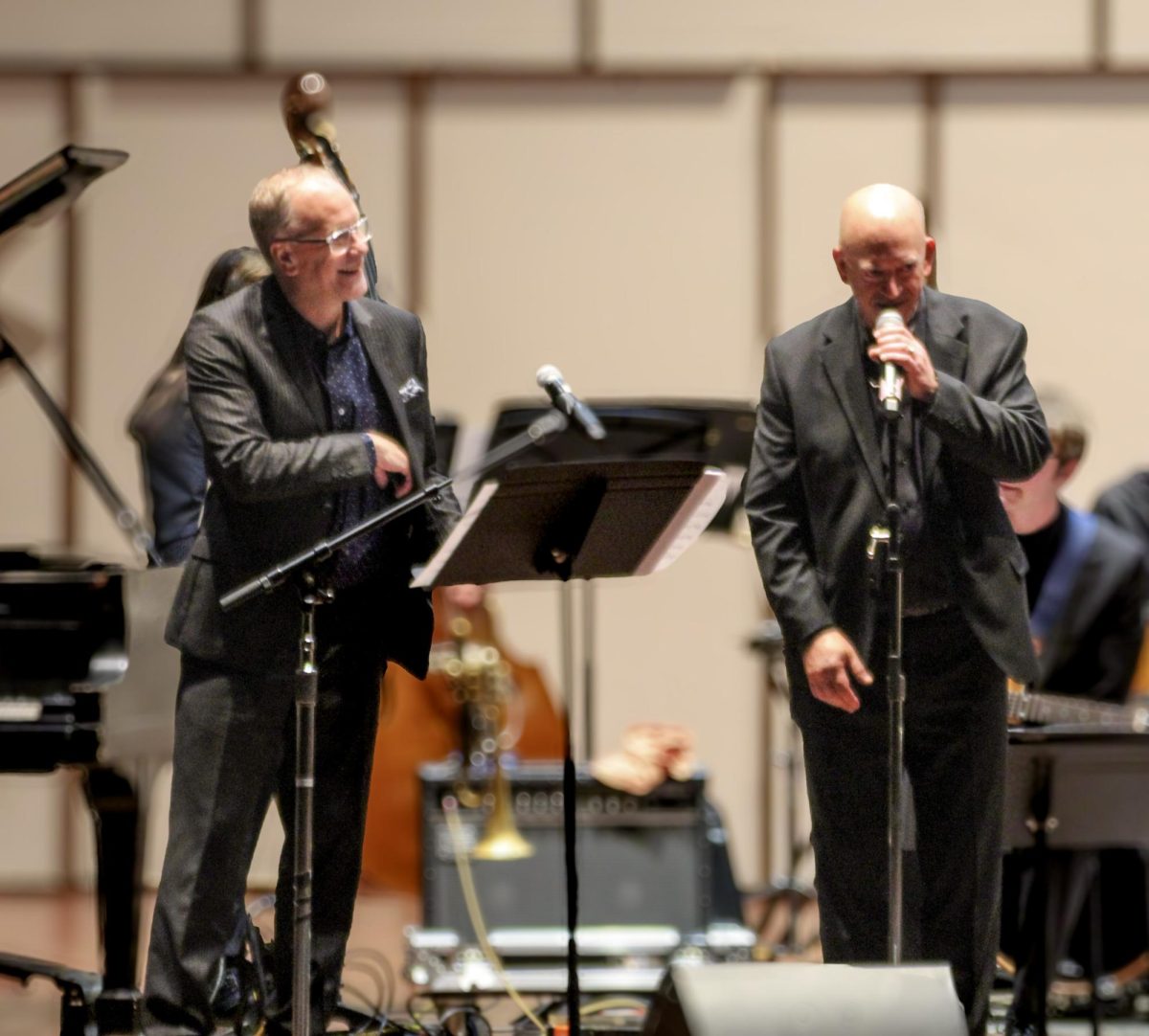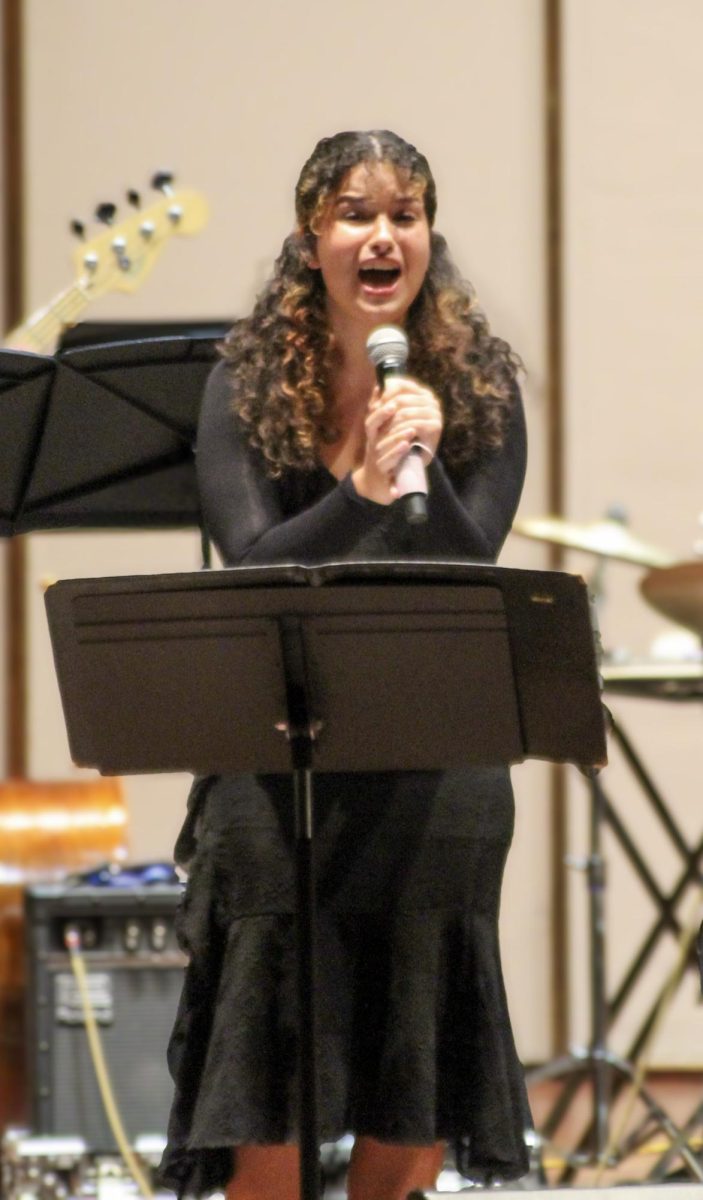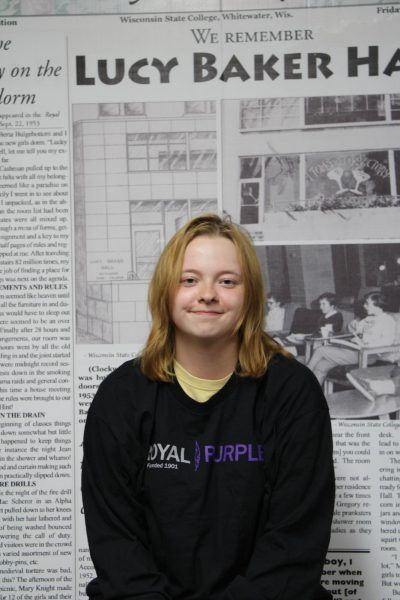A night full of creativity, fun, and joy; the music surrounding the audience as the musicians on stage tell the stories of each tune through their instruments. The improvisations make the audience wonder how they can come up with such complex yet beautiful melodies. You may think they are born with this talent, but that is far from the truth.
When planning a program Dr. Michael Hackett states not everything is planned right away.
“Most programs don’t have a theme to them, but some will be based on a guest artist that joins the program,” Hackett said.
Hackett continued to explain his process of making and deciding on programs.
“I like having contrasting styles and a variety of music. I compliment the strong points of the ensemble and make sure to bring them out. I only take out a tune from the program unless it gets too long, but I am sure the tunes are going to work and rarely cut pieces,” Hackett said.
The jazz ensemble starts preparations for their concert at the beginning of the semester once parts are solidified through auditions. The jazz ensemble works hard at their craft.
“I prepare by doing individual practice, group work with the saxophone section on challenging pieces and make sure we are prepared,” alto lead Anton Saucedo said.
“We play the tune and listen to the tune multiple times,” lead trumpet Jacob Pfannerstill added.
The whole ensemble is given versions of the tunes in the program to listen to to get a better understanding of what the piece emulates and what it sounds like, especially for older pieces from Duke Ellington and many others.
The saxophone section is one of the many sections that help bring the band together and make the vibrant sound that so many love. It’s largely unknown how much happens behind-the-scenes other than practicing and listening to tunes.
“Making memorable melodies that people think is cool, with historic pieces such as Duke Ellington, I try to emulate Johnny Hodges. But overall I listen to Sherman Irby who is a great alto lead player,” Saucedo said.
“When I solo,” lead tenor Woznicki said, “I add what I can fit to sound good, I think of how I can bring in the audience and the band. I find inspiration in Dexter Gordon for melodic lines and Sonny Rollins for a punchier and more forward sound. Improvising is easier on slower tunes, but tends to be a bit tougher with faster tunes.”
Saucedo described being a lead alto player as creating a community feeling among the section, guiding them to play their best and of course being helpful. The saxophone section shows their hard work through playing and it is heard through their tight melodies that shine through the music.
The trumpet section also helps lead the band to bring out vibrant sounds through high pitches or tight harmonies. It may seem easy when listening to the section in a big band, but it’s a lot more complex.
“We play through the tunes and listen closely to stylistic aspects throughout the song that we want to bring out. As lead trumpet, I feel that I am a part of the drive of the band along with the drummer. I help with articulation and dynamics throughout the band and help bring that sound out to the audience,” Pfannerstill said.
“To write a story for the audience, like a book. I want it to be engaging especially since I play for my family in the audience. Sometimes I play for my friends in the audience but they always compliment my playing no matter what,” Pfannerstill added.
Even though Pfannerstill is the lead trumpet, that doesn’t necessarily mean he is considered the best. Ryan Maddix second trumpet explained.
“The chair placement is more dependent on style, but it doesn’t matter what part you are placed on. Usually, higher stuff would be in the lead trumpet part, the second and third trumpet would have the middle melody, and the fourth trumpet would be in charge of harmony,” Maddix said.
The trumpets do a great job of blending and you can hear every part that Maddix explains when you listen closely to them.
The trombone section is filled with low sounds that help amplify the harmony throughout the tunes. Their sound reverberates around the ensemble creating a foundation for the band to rely on. Ryan Cleaver, lead trombone, elaborated on what it’s like being a jazz trombonist.
“It is hard, even though the part isn’t as technical as many others in the band. The tuning is the hardest aspect as a jazz trombonist since you only have a slide. Unlike a trumpet or saxophone which can manipulate fingerings to get in tune, a trombone has to use their embouchure for each note to get it in tune,” Cleaver said.
The trombone section makes their tuning seem easy, but as Cleaver described it, it’s more technical than expected.
“I need to improve my skill, I’m new to the genre and I am working hard on practicing, learning, and listening to transcriptions from jazz trombonists. When I play my solo, I play it for my girlfriend in the crowd and I have fun with it,” Cleaver said.
Another trombonist who tends to take a lot of solos is Trevor Haglin, bass trombone, his solos are unique and melodic. When he is playing, it’s clear how much he enjoys playing jazz whether he is nodding along with the other musicians or is simply playing loud and proud throughout his solo. The trombones are a great harmony for the band and bring out the simple rhythms through the technical works.
The rhythm section is the glue to the band, they help make sure the tempo is steady and the chords can be heard by the soloists. They form a nice foundation for the band and they bring out their parts, whether the drummer is playing complex articulation or the bass is plucking chords fast.
Jazz guitarist Sean Powers elaborated on what it’s like being a jazz guitarist.
“Sometimes it can be rewarding, but sometimes it feels like it’s not needed since the piano and guitar play the same thing,” Powers said.
When you look closely at the placement of the rhythm section, you can see the guitar is closest to the piano as the bass is slightly behind the guitar and the drums are in the back.
“For backgrounds, I listen to that person’s solo and pay attention to who is soloing. With a trumpet solo, I can play out more versus a rhythm section solo, I tend to sit out and let them play out. I work with the rhythm section to help build a foundation similar to a backing track,” Powers said.
Throughout their hard work of keeping time with one another, the rhythm section can be seen communicating with nods or even some verbal cues.
Jazz is a growing genre, it explains the history of where it originated and how it formed into the genre that it is today. Hackett describes jazz as, “represent[ing] different cultural elements such as African American culture and their experience and that element is still infusing in the music.”
“Jazz is a good opportunity to play cool and unique tunes and meet industry musicians,” Maddix added.
Saucedo explains jazz as, “A creative outlet musically and is a big culture in the United States. It’s the only musical genre where you are composing in the moment.”
Cleaver believes that the importance of jazz is the culture and history similar to Hackett and Saucedo’s statements but he explains it as a flourishing genre. Woznicki thinks jazz is a good way to improve on musicianship and self as well as the genre being a good balance of both fun and seriousness. Powers believes that jazz hasn’t changed and it’s very different from how it was when it began. He finds the genre more rule-based. Overall jazz is a great community that supports one another and helps others grow to be their best. Many jazz musicians are amazed by what their fellow members can create when they improvise without needing to see the chord changes in front of them.
Jazz One and Jazz Two hold one concert per semester and Jazz Combos holds a concert a semester. Show support to both ensembles and combos since they have put a lot of time into bringing their all on performance night.
More information can be found through Dr. Hackett or by the Center of the Arts website.




